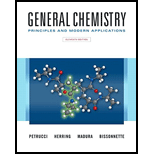
EBK GENERAL CHEMISTRY
11th Edition
ISBN: 9780133400588
Author: Bissonnette
Publisher: VST
expand_more
expand_more
format_list_bulleted
Concept explainers
Question
Chapter 25, Problem 5E
Interpretation Introduction
Interpretation:
To construct the graph for the natural decay series of radionuclide
Concept introduction:
The decay process
Expert Solution & Answer
Want to see the full answer?
Check out a sample textbook solution
Students have asked these similar questions
For the titration of a divalent metal ion (M2+) with EDTA, the stoichiometry of the reaction is typically:
1:1 (one mole of EDTA per mole of metal ion)
2:1 (two moles of EDTA per mole of metal ion)
1:2 (one mole of EDTA per two moles of metal ion)
None of the above
Please help me solve this reaction.
Indicate the products obtained by mixing 2,2-dimethylpropanal with acetaldehyde and sodium ethoxide in ethanol.
Chapter 25 Solutions
EBK GENERAL CHEMISTRY
Ch. 25 - Prob. 1ECh. 25 - Prob. 2ECh. 25 - Prob. 3ECh. 25 - Prob. 4ECh. 25 - Prob. 5ECh. 25 - Prob. 6ECh. 25 - Prob. 7ECh. 25 - Prob. 8ECh. 25 - Prob. 9ECh. 25 - Prob. 10E
Ch. 25 - Prob. 11ECh. 25 - Prob. 12ECh. 25 - Prob. 13ECh. 25 - Prob. 14ECh. 25 - Prob. 15ECh. 25 - Prob. 16ECh. 25 - Prob. 17ECh. 25 - Prob. 18ECh. 25 - Prob. 19ECh. 25 - Prob. 20ECh. 25 - Prob. 21ECh. 25 - Prob. 22ECh. 25 - Prob. 23ECh. 25 - Prob. 24ECh. 25 - Prob. 25ECh. 25 - Prob. 26ECh. 25 - Prob. 27ECh. 25 - Prob. 28ECh. 25 - Prob. 29ECh. 25 - Prob. 30ECh. 25 - Prob. 31ECh. 25 - Prob. 32ECh. 25 - Prob. 33ECh. 25 - Prob. 34ECh. 25 - Prob. 35ECh. 25 - Prob. 36ECh. 25 - Prob. 37ECh. 25 - Prob. 38ECh. 25 - Prob. 39ECh. 25 - Prob. 40ECh. 25 - Prob. 41ECh. 25 - Prob. 42ECh. 25 - Prob. 43ECh. 25 - Prob. 44ECh. 25 - Prob. 45ECh. 25 - Prob. 46ECh. 25 - Prob. 47ECh. 25 - Prob. 48ECh. 25 - Prob. 49ECh. 25 - Prob. 50ECh. 25 - Prob. 51ECh. 25 - Prob. 52ECh. 25 - Prob. 53ECh. 25 - Prob. 54ECh. 25 - Prob. 55ECh. 25 - Prob. 56ECh. 25 - Prob. 57IAECh. 25 - Prob. 58IAECh. 25 - Prob. 59IAECh. 25 - Prob. 60IAECh. 25 - Prob. 61IAECh. 25 - Prob. 62IAECh. 25 - Prob. 63IAECh. 25 - Prob. 64IAECh. 25 - Prob. 65IAECh. 25 - Prob. 66IAECh. 25 - Prob. 67IAECh. 25 - Prob. 68IAECh. 25 - Prob. 69IAECh. 25 - Prob. 70IAECh. 25 - Prob. 71IAECh. 25 - Prob. 72FPCh. 25 - Prob. 73FPCh. 25 - Radioactive decay and mass spectrometry are often...Ch. 25 - Prob. 75SAECh. 25 - Prob. 76SAECh. 25 - Prob. 77SAECh. 25 - Prob. 78SAECh. 25 - Prob. 79SAECh. 25 - Prob. 80SAECh. 25 - Prob. 81SAECh. 25 - Prob. 82SAECh. 25 - Prob. 83SAECh. 25 - Prob. 84SAECh. 25 - Prob. 85SAECh. 25 - Prob. 86SAECh. 25 - Prob. 87SAECh. 25 - Prob. 88SAECh. 25 - Prob. 89SAECh. 25 - Prob. 90SAECh. 25 - Prob. 91SAECh. 25 - Prob. 92SAECh. 25 - Prob. 93SAE
Knowledge Booster
Learn more about
Need a deep-dive on the concept behind this application? Look no further. Learn more about this topic, chemistry and related others by exploring similar questions and additional content below.Similar questions
- Synthesize 2-Ethyl-3-methyloxirane from dimethyl(propyl)sulfonium iodide using the necessary organic or inorganic reagents. Draw the structures of the compounds.arrow_forwardSynthesize 2-Hydroxy-2-phenylacetonitrile from phenylmethanol using the necessary organic or inorganic reagents. Draw the structures of the compounds.arrow_forwardSynthesize N-Methylcyclohexylamine from cyclohexanol using the necessary organic or inorganic reagents. Draw the structures of the compounds.arrow_forward
- Synthesize N-Methylcyclohexylamine from cyclohexanol using the necessary organic or inorganic reagents. Draw the structures of the compounds.arrow_forwardIf possible, please provide the formula of the compound 3,3-dimethylbut-2-enal.arrow_forwardSynthesize 1,4-dibromobenzene from acetanilide (N-phenylacetamide) using the necessary organic or inorganic reagents. Draw the structures of the compounds.arrow_forward
- Indicate the products obtained by mixing (3-oxo-3-phenylpropyl)triphenylphosphonium bromide with sodium hydride.arrow_forwardWe mix N-ethyl-2-hexanamine with excess methyl iodide and followed by heating with aqueous Ag2O. Indicate the major products obtained.arrow_forwardIndicate the products obtained by mixing acetophenone with iodine and NaOH.arrow_forward
- Indicate the products obtained by mixing 2-Propanone and ethyllithium and performing a subsequent acid hydrolysis.arrow_forwardIndicate the products obtained if (E)-2-butenal and 3-oxo-butanenitrile are mixed with sodium ethoxide in ethanol.arrow_forwardQuestion 3 (4 points), Draw a full arrow-pushing mechanism for the following reaction Please draw all structures clearly. Note that this intramolecular cyclization is analogous to the mechanism for halohydrin formation. COH Br + HBr Brarrow_forward
arrow_back_ios
SEE MORE QUESTIONS
arrow_forward_ios
Recommended textbooks for you
 ChemistryChemistryISBN:9781305957404Author:Steven S. Zumdahl, Susan A. Zumdahl, Donald J. DeCostePublisher:Cengage Learning
ChemistryChemistryISBN:9781305957404Author:Steven S. Zumdahl, Susan A. Zumdahl, Donald J. DeCostePublisher:Cengage Learning Chemistry: An Atoms First ApproachChemistryISBN:9781305079243Author:Steven S. Zumdahl, Susan A. ZumdahlPublisher:Cengage Learning
Chemistry: An Atoms First ApproachChemistryISBN:9781305079243Author:Steven S. Zumdahl, Susan A. ZumdahlPublisher:Cengage Learning
 Chemistry: Principles and PracticeChemistryISBN:9780534420123Author:Daniel L. Reger, Scott R. Goode, David W. Ball, Edward MercerPublisher:Cengage Learning
Chemistry: Principles and PracticeChemistryISBN:9780534420123Author:Daniel L. Reger, Scott R. Goode, David W. Ball, Edward MercerPublisher:Cengage Learning Chemistry by OpenStax (2015-05-04)ChemistryISBN:9781938168390Author:Klaus Theopold, Richard H Langley, Paul Flowers, William R. Robinson, Mark BlaserPublisher:OpenStax
Chemistry by OpenStax (2015-05-04)ChemistryISBN:9781938168390Author:Klaus Theopold, Richard H Langley, Paul Flowers, William R. Robinson, Mark BlaserPublisher:OpenStax Principles of Instrumental AnalysisChemistryISBN:9781305577213Author:Douglas A. Skoog, F. James Holler, Stanley R. CrouchPublisher:Cengage Learning
Principles of Instrumental AnalysisChemistryISBN:9781305577213Author:Douglas A. Skoog, F. James Holler, Stanley R. CrouchPublisher:Cengage Learning

Chemistry
Chemistry
ISBN:9781305957404
Author:Steven S. Zumdahl, Susan A. Zumdahl, Donald J. DeCoste
Publisher:Cengage Learning

Chemistry: An Atoms First Approach
Chemistry
ISBN:9781305079243
Author:Steven S. Zumdahl, Susan A. Zumdahl
Publisher:Cengage Learning


Chemistry: Principles and Practice
Chemistry
ISBN:9780534420123
Author:Daniel L. Reger, Scott R. Goode, David W. Ball, Edward Mercer
Publisher:Cengage Learning

Chemistry by OpenStax (2015-05-04)
Chemistry
ISBN:9781938168390
Author:Klaus Theopold, Richard H Langley, Paul Flowers, William R. Robinson, Mark Blaser
Publisher:OpenStax

Principles of Instrumental Analysis
Chemistry
ISBN:9781305577213
Author:Douglas A. Skoog, F. James Holler, Stanley R. Crouch
Publisher:Cengage Learning